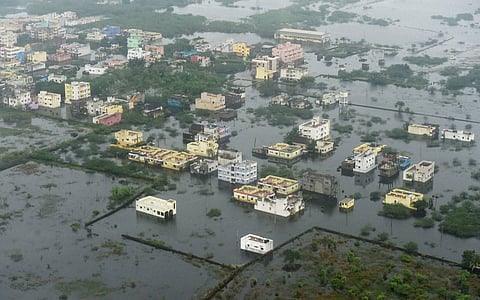

CHENNAI: Tamil Nadu is all set to deploy an ‘intelligent flood warning system’ in Chennai, which will enable officials to get area-wise inundation details during the monsoon. The technology, called CFLOWS, is India’s first integrated coastal flood warning system. It was conceptualised by the office of the Principal Scientific Adviser to the Union Government, after the devastating 2015 Chennai floods.
The system is being considered a game-changer, not just for Chennai, but also for other coastal cities such as Mumbai where urban flooding has become the norm. The link to the fully-operational CFLOWS will be formally handed over to the State Disaster Management cell on Friday, by the National Centre for Coastal Research (NCCR).
J Radhakrishnan, the officer who heads disaster management and mitigation in Tamil Nadu, said CFLOWS would be deployed immediately. It would be tested for 1-2 weeks before being integrated with TN-Smart, the State government’s disaster management portal.“To begin with, the system is designed for core urban area of the city, spread across 426 sq.km. Later, it will be extended to cover the Greater Chennai Corporation limits, for which work is underway,” he said.
‘Flood library’ of Chennai developed
Explaining how CFLOWS works, NCCR director MV Ramanamurthy said it is a Web GIS-based decision support system, integrating data and outputs, derived from weather forecast, hydrologic, hydraulic and hydrodynamic models. “Based on these models a flood library, comprising 796 flood inundation scenarios, were developed corresponding to different rainfall return periods, tidal and water discharge conditions. A complete WebGIS-based decision support system has been built with six modules as per the requirement of TN government and the system will be tested this monsoon,” he said.
Tune Usha of NCCR said a Red Atlas-Action Plan Map has been developed that will serve as a ready reckoner during flood mitigation operations. Besides NCCR, India Meteorological Department (IMD), National Central for Medium-Range Weather Forecast (NCMRWF), Indian National Center for Ocean Information Services (INCOIS), IIT-Madras, IIT-Bombay, IRS-Anna University and IISC Bangalore have chipped-in to realise the project.
How it works:
Scope for improvement
Though CFLOWS as a product is fully operational, its accuracy depends on quality of inputs. For instance, IMD has only two automatic weather stations in Chennai. If the forecast says 20 cm rainfall for Chennai, the system will assume all the areas in the city will receive 20 cm, which may not be the case. To improve accuracy and get more localised results, it is pivotal to enhance the number of weather stations.
Mrutyunjay Mohapatra, Director-General of Meteorology, IMD, acknowledged that the number of weather stations has to be increased. “We have plans to add 30 more stations in Chennai.”
What is CFLOWS & how it works
1. It’s an integrated GIS-based decision support system to provide forecast on potential inundation 10 days in advance
2. Ministry of Earth Sciences and TN government have jointly developed it
3. It will be hosted and made operational at NCCR with meteorological data inputs from IMD, NCMRWF and INCOIS
4. The system can simulate the scenario and predict what will happen in a particular area
5. It has 6 modules, including 3D visuals of flooding in infrastructure, buildings, roads and ward boundaries
6. Mirror images of CFLOWS will be setup in CRA, Greater Chennai Corporation and IMD
Why Chennai is prone to flooding
Chennai is prone to flooding due to a combination of topography, high population density and unplanned rapid urbanisation.
Though it is blessed with three natural drainage systems- Cooum, Adyar and Buckingham Canal, the city literally went underwater in 2015 with three consecutive weather systems bringing unprecedented rain.
Realtor wants water body reclassified
While efforts are being taken on the one side to prevent devastating disasters such as the 2015 Chennai floods, rampant development over the few existing water-bodies in the city have residents worried. People living around a six-acre waterbody in Nandambakkam, along the Adyar River, are up in arms as a real estate developer has approached the CMDA seeking reclassification of the land.
Sources tell Express that this is the third time the developer has approached CMDA for that piece of land. “While the land is classified as waterbody in the records, the developer is trying to use a loophole to get it changed,” say official sources.
In Video: